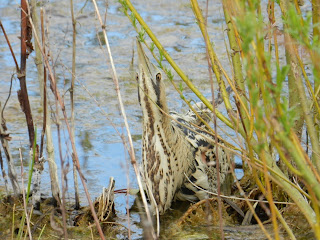MONDAY 29 APRIL
When I went away in mid April, it still felt
like Winter in the field. Now I am back, it still feels like Winter in the
field..........
Anyway, with a brisk NNW wind blowing,
temperatures hovering around 8 degrees C but relatively clear blue skies, I set
forth on a day's birding on the local front, after being lured away in recent
days by the likes of Rock Thrush and Eastern Subalpine
Warbler......
WILSTONE RESERVOIR was my first port of call
where Roy Hargreaves had discovered a singing male Wood Warbler early morning in
the vicinity of the Drayton Bank Hide. Both Mike Campbell and Cliff Tack had
already spent time looking without success, so putting in a further hour on top
with no bird was not looking good. Birding in this vicinity did produce a
flyover COMMON CROSSBILL at 1045, a flyover Linnet, singing Common Chiffchaff
behind the hide, 2 COMMON WHITETHROATS, 2 different singing male WILLOW
WARBLERS, at least 9 Blackcaps, Long-tailed Tit and a pair of COMMON
TREECREEPERS, whilst on the reservoir proper, the two drake Wigeon and a single
Black-headed Gull. A spell of sunshine produced Small Tortoiseshell and Peacock
butterfly.
Most concerning was the mindless vandalism
to have taken place overnight. Our information board by the car park being
smashed, uprooted and thrown into the reservoir.
A flock of 8 House Sparrows was by the farm
shop
After giving up on the Wood Warbler, I
joined Martin, JT and Anna Marett at STARTOP'S END, where a full
breeding-plumaged BLACK TERN was performing, along with 44 Common Terns and the
3 RED-CRESTED POCHARDS.
Knowing that Steve Blain had relocated the
NORTH AMERICAN GREEN-WINGED TEAL at 100 Acre Pools east of Priory Country Park
(Bedfordshire), I decided to switch counties. Just as I drove away, Joan and
Anna had an OSPREY fly from Marsworth to Wilstone, bad timing or what. Anyhow,
stopping off at BROGBOROUGH LAKE (BEDS) on the way, I was pleased to see 5
ARCTIC TERNS, a COMMON WHITETHROAT and the continuing SLAVONIAN GREBE, now in
full summer attire.
I did an extensive sweep of 100 ACRE LAKES
(BEDS) but failed in my quest to locate the drake straggler - it had flown. Not
much to be found apart from a single COMMON SANDPIPER, 6 COMMON WHITETHROATS and
a singing male SEDGE WARBLER.
Whilst on site, I received a call from Ian
Williams. He had visited WILSTONE in his lunch hour and had relocated the WOOD
WARBLER - time to move on. Just over twenty minutes later, I was back at
WILSTONE where COMMON SWIFT numbers had dramatically increased from about 130 to
220. Swiftly walking round to the hide and past a rather happy looking Mike
Campbell, I was rather surprised to hear the male WOOD WARBLER after just a few
minutes. It was inhabiting a dense area of Hawthorn scrub about 90 yards NW of
the Drayton Bank Hide but was far from easy to see. In fact, it took Peter
Brazier and I over an hour to get really good views but well worth it as it was
a brightly marked individual (see Peter and Dave Hutchinson's images above). It
sang about once every five minutes and kept high in the canopy, often feeding on
the newly flowering buds of the Black Poplar trees. After missing two different
birds at Amwell and two at Spade Oak, I was very relieved at finally getting
this one - Wood Warbler now being a pretty scarce bird in our
region.
As I walked back to the car, a first-summer
Mute Swan flew in and Tufted Ducks had increased to 171 birds.
At STARTOP'S END, the tern flock now
included two nice ARCTIC TERNS within their ranks, with 2 Grey Wagtails, 11
Common Swifts and several House Martins noted.
MARSWORTH held the Greylag Goose pair and at
least 4 Lesser Black-backed Gulls, with the horsefields producing no less than
14 YELLOW WAGTAILS, a BLUE-HEADED WAGTAIL and 46 Barn Swallows.
With plenty of time to check the hills, I
headed towards Ivinghoe Beacon but was diverted at the last minute by a call
from LEIGHTON BUZZARD. A EURASIAN BITTERN had been found on the tiny Dragonfly
pools at LEDBURN ROAD, TIDDENFOOT (BEDS) - a species I had managed to miss in
the county this winter. Luckily, being just seven miles away, I was there within
10 minutes - and luckier still, finder Rory Morrisey was just getting back to
the car park. Rory escorted me part way to the site, then Cliff Tack took over -
Mike Wilkes and his wife and Bob Henry staying with the bird.
Getting to Bob he exclaimed ''It's in my
'scope'' and looking through the viewfinder I was shocked to find such an
emaciated bird. It was ludicrously close (10 feet) and was sat in the water like
a goose. Something was seriously, seriously wrong. I phoned Andy Plumb and Steve
Blain to see if anyone else had shown an interest and then waited for Johnny
Lynch to arrive from Tring. I suspected that the bird had collided with overhead
power cables and I was right, as after half an hour we captured the bird - it
had a broken wing and a slightly damaged leg (see photos below).
Certainly an eventful day








No comments:
Post a Comment